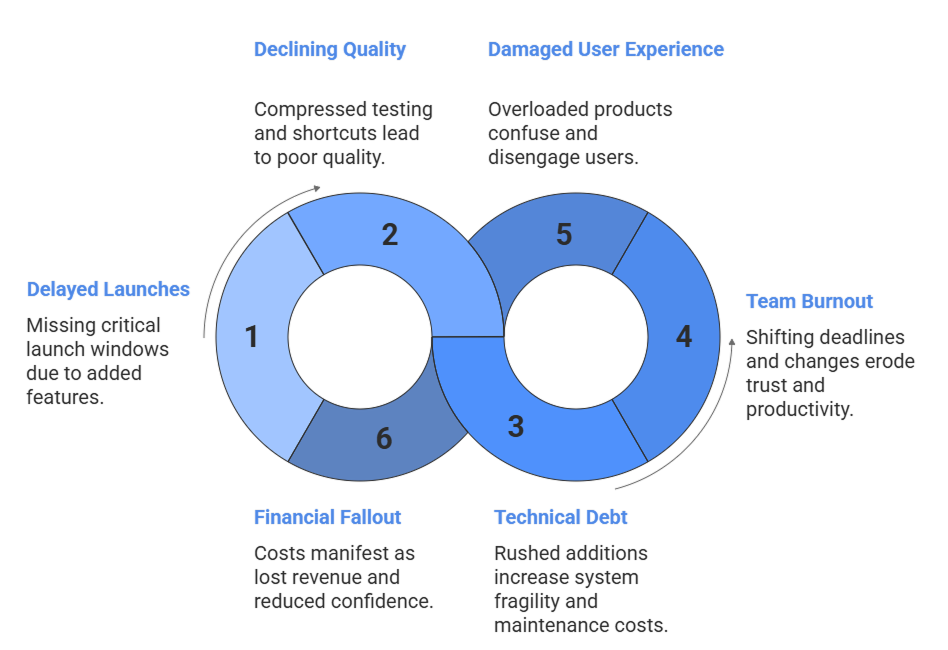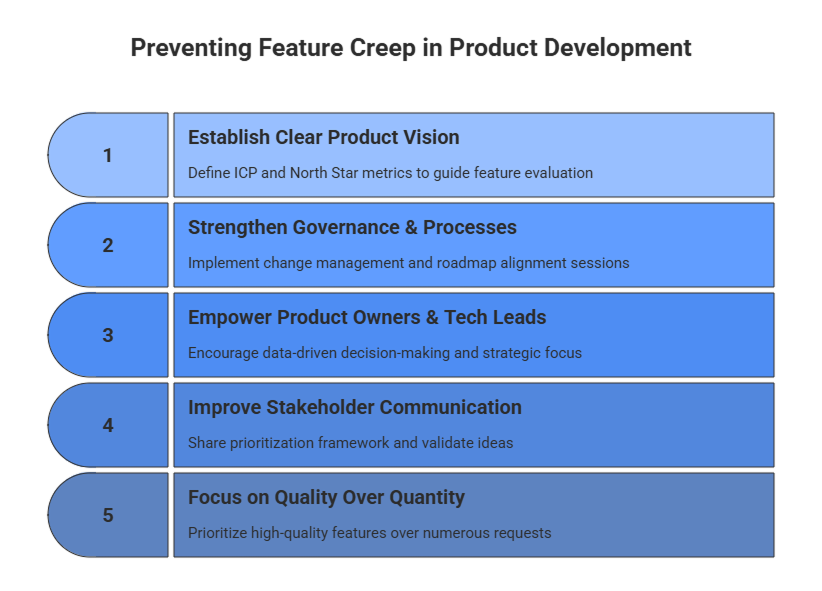
Imagine this: your team set out to build a clean, focused MVP with a tight deadline. The scope was clear, the roadmap was aligned, and stakeholders were on board. Fast-forward three months, and the product looks unrecognizable – every sprint added “just one more” feature. Deadlines slipped, engineers grew frustrated, QA struggled to keep up, and the once-simple vision now feels like a patchwork of compromises.
This is feature creep – the continuous addition of new features beyond a product’s original scope. While it may start with good intentions – meeting client demands, addressing competitor moves, or exploring “quick wins” – it often leads to delayed launches, ballooning budgets, and declining product quality.
For CTOs, feature creep is more than a project management headache; it’s a strategic risk. According to the Project Management Institute, nearly 50% of projects experience scope creep, and in tech, that often translates into missed market opportunities, technical debt, and reduced team morale. In SaaS specifically, studies show that up to 80% of new features go unused by customers, leaving behind code that slows velocity and drains resources.
In this guide we’ll explore the real costs of feature creep, why it happens, the red flags to watch for, and – most importantly – practical strategies and frameworks to prevent it without stifling innovation. By the end, you’ll have an actionable playbook to protect your roadmap, safeguard team performance, and deliver products that are not only feature-rich but also feature-right.
- The Real Costs of Feature Creep
- Why Feature Creep Happens
- Red Flags That Feature Creep Is Taking Over
- When It’s Okay to Add Features
- Strategies to Prevent Feature Creep
- Recovery Playbook: When Creep Has Already Occurred
- Practical Tools & Frameworks CTOs Can Use
- How Developex Helps Companies Control Feature Creep
- Final Thoughts
The Real Costs of Feature Creep
Feature creep is rarely obvious at first. It often hides behind good intentions – listening to customers, keeping up with competitors, or showing progress to investors. But left unchecked, its impact compounds quickly across every dimension of product delivery.

Delayed Launches
Each “must-have” feature adds layers of design, development, and testing. For hardware and consumer electronics, this often means missing critical launch windows such as CES or IFA, where visibility and timing are everything. In SaaS, delays can derail fundraising milestones or IPO readiness, leaving competitors to seize market share.
Declining Quality
When timelines don’t flex with scope, quality inevitably suffers. Testing gets compressed, and shortcuts creep in. The consequences include untested features, regression bugs in previously stable areas, and a backlog of “fix later” tickets that rarely get resolved.
Technical Debt Piling Up
Every rushed addition builds fragility into the system. Architecture is bent instead of evolved, integrations become risky, and maintenance costs rise. Over time, teams spend more energy paying down debt than delivering customer value – slowing release velocity and increasing risk.
Team Burnout and Morale Issues
Scope creep isn’t just a technical problem; it’s a human one. Constantly shifting deadlines and mid-sprint changes erode trust and focus. Developers lose momentum, productivity drops, and top performers are more likely to walk away – taking valuable knowledge with them.
Damaged User Experience
More features do not equal more value. Products overloaded with functionality often become cluttered, confusing, and harder to adopt. Instead of delighting users, they dilute the core value proposition and drive disengagement.
Financial Fallout
Ultimately, the costs show up on the balance sheet. Feature creep contributes to lost revenue from delayed launches, reduced investor confidence from slipping milestones, and higher long-term expenses from rework, refactoring, and customer support.
The feature creep doesn’t just slow a product – it undermines the entire business strategy. Recognizing these costs early gives CTOs leverage to push back against uncontrolled scope expansion.
Why Feature Creep Happens
Feature creep doesn’t happen by accident – it grows out of a combination of organizational pressures and technical process gaps. For CTOs, spotting these root causes is the first step toward prevention.

Organizational Drivers
Stakeholder pressure and competing priorities. Executives, sales teams, and customer-facing departments often push for “just one more feature” to close deals or satisfy investors. Without discipline, these requests overload the roadmap.
How to counter: run executive-aligned roadmap reviews each quarter and set clear decision rights so only strategically aligned features move forward.
Market FOMO and competitive response. When competitors announce new features, the urge to react quickly can be strong. But chasing every shiny object often leads to wasted effort.
How to counter: validate with customer research and usage data before responding. Ask whether a feature aligns with your ICP and North Star metrics, or if it’s simply vanity.
Lack of a clear product vision. Without a defined North Star, teams drift. Features that look valuable individually may add little to the overall product.
How to counter: anchor every roadmap decision to ICP needs and core metrics such as activation, retention, or NDR. Revisit and reinforce the product vision regularly across leadership and engineering.
Technical and Process Gaps
Weak requirement definition. Vague specs or missing acceptance criteria create room for uncontrolled scope growth mid-sprint.
How to counter: enforce detailed PRDs and maintain a clear “definition of done” that includes testing and documentation.
No impact assessment frameworks. When effort vs. value isn’t measured, every feature feels urgent, leading to bloated backlogs.
How to counter: use RICE scoring or an impact/effort matrix, and let data – not intuition – guide prioritization.
Poor cross-team communication. When product, engineering, and business units operate in silos, scope changes slip in without analysis.
How to counter: establish a formal change request workflow and make backlog grooming a regular, cross-functional practice.
Why SaaS Is Especially Vulnerable to Feature Creep
SaaS companies face unique pressures that make them especially prone to scope expansion:
- Customer Success Pressure: Enterprise clients often demand custom features to justify renewals or expansions. Without guardrails, teams end up building “one-off” features that add technical debt but little long-term value.
- Always-On Competition: In SaaS, new features from rivals can appear overnight, tempting teams to react before validating demand.
- Subscription-Driven Metrics: Retention and expansion are tied to perceived value. This creates a risk of equating “more features” with “more value,” when in reality, unused or poorly adopted features hurt long-term growth.
The safeguard for SaaS leaders is a core-product-first mindset: prioritize features that strengthen the platform’s value for the majority of customers, not just a vocal few.
Red Flags That Feature Creep Is Taking Over
Feature creep often sneaks in gradually, disguised as responsiveness or innovation. But certain patterns are clear signals that scope expansion is starting to erode product focus.
1. Deadlines Keep Slipping: When timelines are pushed repeatedly due to “just one more feature,” it’s a sign that scope has outpaced capacity. Missed launches hurt credibility with both customers and investors.
2. Roadmaps Look More Like Wish Lists: If your roadmap is filled with every stakeholder’s request instead of a curated set of strategic priorities, you’re no longer steering the product – you’re reacting.
3. Backlog Overflowing With “Nice-to-Haves”: A healthy backlog prioritizes high-value items tied to business outcomes. A bloated backlog of “nice-to-have” features signals weak governance and lack of prioritization discipline.
4. Engineers Complaining About Shifting Specs: When specs change mid-sprint or requirements are unclear, frustration rises. This creates morale issues and increases the risk of hidden technical debt.
5. Scope Changes Without Impact Analysis: Adding new functionality mid-sprint – or worse, mid-release – without analyzing the effect on velocity, quality, and dependencies is a hallmark of feature creep.
6. Declining Adoption of New Features (SaaS-Specific): For SaaS products, one of the clearest indicators is low usage of recently shipped features. If customers aren’t adopting what’s being built, the roadmap is likely being driven by noise, not strategy.
Spotting these red flags early allows CTOs to intervene before damage compounds – by pausing to reassess priorities, re-align stakeholders, and protect team velocity.
When It’s Okay to Add Features
Not every new feature is a threat – sometimes adding functionality is critical for growth, compliance, or competitive positioning. The key is intentional, measured decision-making.
1. Critical Customer Needs: Features that unlock measurable revenue, retention, or adoption for a significant portion of your customer base are usually justified. Example: A SaaS platform adds a reporting module that improves onboarding for 70% of clients.
2. Regulatory or Compliance Requirements: Features required to meet legal, security, or industry standards cannot be ignored. Example: GDPR consent management in EU-facing SaaS products or SOC2 compliance reporting.
3. Competitive Parity (When Strategically Justified): Occasionally, competitors introduce capabilities that affect market perception. Only add features if they directly support your product vision or critical market positioning.
4. Controlled, Intentional Scope Adjustments: Before adding any new feature, CTOs should ask:
- Does it align with the product vision?
- Will it meaningfully improve user adoption or retention?
- Can it be delivered without jeopardizing existing priorities?
Pro Tip: Use a simple decision checklist to evaluate each request. This keeps discussions objective, reduces emotional pressure, and ensures the team only builds features that deliver real value.
Strategies to Prevent Feature Creep
Preventing feature creep starts with building a culture and process that naturally limits unnecessary scope expansion while still fostering innovation. Here’s how CTOs can approach it strategically.
Anchor to a Clear Product Vision
A well-defined product vision is your first line of defense. Clearly establish your Ideal Customer Profile (ICP) and North Star metrics – the key indicators of product success. Every feature request should be evaluated against these metrics. Features that don’t move the needle for your ICP or North Star goals should remain on the backlog. Reinforce this vision consistently across engineering, product, and business teams to maintain alignment.
Strengthen Governance & Processes
Robust processes reduce reactive decision-making. Implement a change management workflow to handle new requests or scope changes. Hold quarterly roadmap alignment sessions with executives and key stakeholders to ensure priorities remain strategic rather than reactive. Document clear decision-making criteria for feature approvals, so teams have transparency and consistency in what gets built.
Empower Product Owners & Tech Leads
Product owners and technical leads must feel confident to say “no” or “not now” when requests conflict with the roadmap or core priorities. Encourage them to back decisions with data and strategic rationale, not just personal judgment. Empowered leaders maintain focus and prevent low-value features from slipping in.
Improve Stakeholder Communication
Transparent communication keeps everyone on the same page. Share your prioritization framework openly with stakeholders, and use prototypes, MVPs, or A/B tests to validate ideas before committing development resources. Regularly communicate trade-offs and expected outcomes to reduce pressure to overdeliver and align expectations.
Focus on Quality Over Quantity
Rather than trying to satisfy every request, focus on delivering fewer, high-quality features that provide real value. Well-executed features enhance adoption, maintain a clean user experience, and reduce technical debt. Build a culture where strategic “no’s” are celebrated, reinforcing disciplined delivery.

Key Takeaway: By anchoring decisions in vision, governance, and data, CTOs can prevent feature creep before it starts, ensuring teams build the right features efficiently.
Recovery Playbook: When Creep Has Already Occurred
Even the most disciplined teams can fall victim to feature creep. The good news: with a structured recovery plan, CTOs can regain control, restore focus, and protect both product and people.
Step 1. Audit and Trim Scope
Start by reviewing everything currently in flight. Which features are unfinished, low-value, or already obsolete? These should be paused or removed. To stabilize the roadmap, freeze new requests temporarily – this gives teams breathing room and prevents creep from compounding.
Step 2. Address Technical Debt
Feature creep often leaves behind fragile architecture, redundant code, or risky integrations. Catalog these problem areas and turn them into a visible backlog. Dedicate sprints or capacity specifically to refactoring and remediation, ensuring that the product’s foundation becomes stable again before more features are layered on.
Step 3. Re-Align Stakeholders
Scope creep usually reflects misalignment, so it’s critical to reset expectations with executives, product leads, and business teams. Re-prioritize using clear criteria – such as customer value, technical feasibility, and strategic impact. Frameworks like RICE or an impact/effort matrix can make tough decisions more objective and transparent.
Step 4. Restore Team Morale
Teams living through feature creep often feel demoralized. Acknowledge the overcommitments of the past, then reset with achievable sprint goals focused on finishing the highest-priority items. Recognize progress and celebrate small wins – these gestures rebuild confidence and momentum faster than any retrospective alone.
Step 5. Communicate Externally
Customers and investors notice when timelines slip. Rather than hiding, be transparent about revised plans and scope adjustments. Frame the message around delivering higher-value, more reliable features, not just delays. Clear communication maintains trust and credibility even during recovery.
Practical Tools & Frameworks CTOs Can Use
CTOs can leverage structured tools and frameworks to prevent feature creep and make decision-making more objective. These approaches help teams prioritize effectively, track progress, and maintain focus on what truly matters.
1. Prioritization Frameworks
Not all features are created equal. Prioritization frameworks help assess value versus effort, ensuring high-impact work gets done first. Common approaches include:
Prioritization frameworks help CTOs and product leaders systematically decide which features to build, defer, or drop. Using these methods ensures development effort aligns with strategic goals, customer impact, and team capacity.
Must-Should-Could-Won’t Framework (MSCW) – Categorizes features as Must-have, Should-have, Could-have, or Won’t-have. It Provides a simple, intuitive categorization that aligns engineering, product, and business stakeholders on priorities.
- Must-have: Features essential for product functionality or regulatory compliance; the product cannot launch without them.
- Should-have: Important features that add significant value but are not critical for launch.
- Could-have: Nice-to-have features that improve user experience but can be postponed.
- Won’t-have (for now): Features that are explicitly excluded from the current scope, avoiding distraction and scope drift.
RICE (Reach, Impact, Confidence, Effort) – Scores features based on Reach, Impact, Confidence, and Effort. It generates a numerical score for each feature, allowing objective comparison across requests, even when different teams or stakeholders propose them.
- Reach: How many users or customers will benefit from the feature within a defined period.
- Impact: The expected effect on key metrics like retention, revenue, or engagement.
- Confidence: The degree of certainty in your estimates and assumptions.
- Effort: Total resources required (time, engineering hours, cost) to deliver the feature.
Kano Model – Differentiates between basic, performance, and delight features to balance user satisfaction with development effort. Kano Models helps balance development effort against user satisfaction, ensuring the team delivers both essential functionality and strategic differentiators without overbuilding.
- Basic Features: Core functionalities that users expect; missing these causes dissatisfaction.
- Performance Features: Features where “more is better”; they directly improve user satisfaction and are often measurable.
- Delight Features: Unexpected enhancements that create strong positive reactions, but are not required for basic satisfaction.
2. Documentation Best Practices
Clear, structured documentation reduces misunderstandings and scope drift. Key practices include:
- Product Requirement Documents (PRDs): Define feature objectives, user stories, and acceptance criteria.
- Definition of Done: Ensure everyone knows when a feature is truly complete, including testing and QA checkpoints.
3. Metrics to Track
Monitoring the right metrics gives visibility into potential scope creep and helps guide future decisions. Important metrics include:
- Release velocity: Measures how fast the team delivers features.
- Scope change frequency: Tracks how often mid-sprint or roadmap changes occur.
- Feature adoption rates: Highlights which features are actually used by customers, helping avoid unnecessary complexity.
4. Decision Templates
Decision templates make prioritization objective and transparent. A simple impact/effort matrix allows teams to visually compare features, ensuring limited resources go to the highest-value work.
5. SaaS-Specific Tools
For SaaS products, specialized tools can help manage feature creep while maintaining agility:
- Feature flagging platforms like LaunchDarkly allow controlled rollouts and experimentation without bloating the core product.
- Analytics tools like Mixpanel or Amplitude provide adoption and engagement data, guiding decisions with real usage patterns.
Key Takeaway: By combining frameworks, documentation, metrics, and modern SaaS tools, CTOs can make feature decisions more objective, data-driven, and aligned with product strategy, reducing the risk of uncontrolled scope expansion.
How Developex Helps Companies Control Feature Creep
At Developex, we’ve seen firsthand how even the most innovative projects can stumble when scope expands unchecked. Across SaaS, consumer electronics, IoT, gaming, and enterprise software, the pattern is the same: ambition outpaces discipline, and product teams struggle to keep delivery aligned with strategy.
What has worked consistently in our experience:
- Structured Scope Management – We help teams put in place clear intake and evaluation processes that filter requests through business priorities, technical feasibility, and customer value.
- Prioritization and Roadmap Discipline – By applying frameworks like RICE or MSCW, teams gain objective tools to say “yes” to the right features and “not now” to those that don’t fit.
- Iterative Delivery Models – Breaking down releases into smaller, validated increments allows organizations to capture value earlier while avoiding the pitfalls of massive, all-or-nothing scope expansions.
- Cross-Domain Experience – Whether it’s a SaaS product pressured by enterprise clients, a hardware device with tight go-to-market deadlines, or a gaming accessory where UX is critical, our teams bring lessons learned from diverse industries to keep products focused, competitive, and launch-ready.
The goal is always the same: deliver the right features, at the right time, without letting feature creep derail quality, timelines, or market opportunities.
Final Thoughts
Feature creep is rarely about bad decisions – it’s about too many good intentions left unchecked. For CTOs, managing it isn’t just a matter of process discipline; it’s about protecting the product’s focus, the team’s momentum, and the company’s long-term strategy.
By anchoring every decision to a clear product vision, applying structured prioritization frameworks, and maintaining transparent communication across stakeholders, leaders can foster innovation without losing control. The most successful products aren’t those with the most features – they’re the ones that deliver the greatest value with clarity, speed, and consistency.
At Developex, we help organizations strike that balance – empowering teams to scale smart, modernize safely, and build products that stay lean, purposeful, and market-ready.





